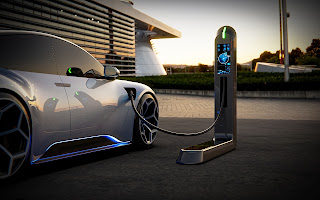Electric cars, also known as electric vehicles (EVs), operate using an electric powertrain instead of a traditional internal combustion engine (ICE) that runs on gasoline or diesel. Electric cars are powered by electricity stored in batteries, and they offer several advantages, including lower emissions, reduced operating costs, and a quieter driving experience. Here's how electric cars work:
1. Battery Pack: Electric cars are equipped with a large battery pack composed of numerous individual cells. These batteries store electrical energy, which powers the car's electric motor and other systems.
2. Electric Motor: Electric cars use an electric motor to convert electrical energy from the battery into mechanical energy that drives the wheels. Electric motors are known for their high efficiency and instant torque delivery, which results in responsive acceleration.
3. Power Electronics: Power electronics components, such as inverters and converters, manage the flow of electricity between the battery and the electric motor. They convert the direct current (DC) from the battery into the alternating current (AC) required by the motor.
4. Transmission: Many electric cars use a single-speed transmission because electric motors can provide a wide range of torque and speeds without the need for multiple gears. This simplifies the drivetrain and improves efficiency.
5. Charging: Electric cars are charged by connecting them to an external power source, usually through charging stations or wall outlets. Charging times vary based on the battery capacity and charging speed. There are three main levels of charging:
- Level 1: Standard 120V household outlets. Slow charging suitable for overnight charging.
- Level 2: 240V charging stations. Faster charging that's commonly used at home and public charging points.
- Level 3 (DC Fast Charging): High-powered charging stations that provide rapid charging, often found along highways and for quick top-ups.
6. Regenerative Braking: Electric cars often use regenerative braking systems. When the driver releases the accelerator or applies the brakes, the electric motor acts as a generator, converting some of the kinetic energy back into electrical energy to recharge the battery. This technology improves efficiency and extends driving range.
7. Onboard Computer and Software: Electric cars are equipped with sophisticated onboard computers and software that manage various functions, including battery management, energy flow optimization, and vehicle diagnostics.
8. User Interface: Modern electric cars feature user-friendly interfaces that provide information about battery status, range estimation, charging locations, and energy consumption. Touchscreens, mobile apps, and voice commands are commonly used for user interaction.
9. Range and Efficiency: Electric cars have a range that depends on factors like battery capacity, driving style, terrain, and weather conditions. Advances in battery technology are continually improving the range and efficiency of electric vehicles.
10. Environmental Benefits: Electric cars produce zero tailpipe emissions, reducing air pollution and greenhouse gas emissions. Their environmental impact also depends on the source of the electricity used for charging. Renewable energy sources further enhance their eco-friendliness.
Overall, electric cars offer a cleaner and more sustainable mode of transportation by utilizing electricity as a power source, contributing to the reduction of carbon emissions and dependence on fossil fuels.
